The Contact Lens Inspection Equipment Market is estimated to be valued at USD 1.3 billion in 2025 and is projected to reach USD 3.2 billion by 2035, registering a compound annual growth rate (CAGR) of 9.3% over the forecast period.
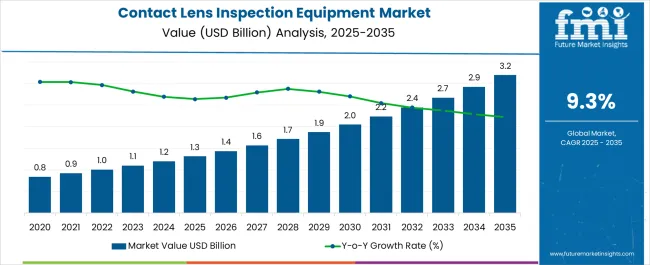
| Metric | Value |
|---|---|
| Contact Lens Inspection Equipment Market Estimated Value in (2025 E) | USD 1.3 billion |
| Contact Lens Inspection Equipment Market Forecast Value in (2035 F) | USD 3.2 billion |
| Forecast CAGR (2025 to 2035) | 9.3% |
The Contact Lens Inspection Equipment market is experiencing steady growth, driven by the increasing adoption of contact lenses globally and the rising emphasis on quality control in the optical industry. The growing prevalence of vision disorders and the expansion of the contact lens user base are creating higher demand for efficient inspection equipment to ensure product safety, accuracy, and comfort. Technological advancements in inspection devices, including automated optical imaging, magnification systems, and integrated software analysis, are enhancing inspection precision and reducing human error.
Regulatory requirements and industry standards for hygiene, safety, and optical quality are further driving the adoption of advanced inspection tools. Manufacturers are increasingly focusing on improving throughput, efficiency, and repeatability to meet the growing demand for high-quality lenses.
The rising preference for disposable lenses, coupled with the need for rapid inspection and compliance with sterilization protocols, is shaping market dynamics As the contact lens industry continues to grow, investment in both manual and automated inspection equipment is expected to drive sustained expansion, supporting quality assurance and operational efficiency across ophthalmic product manufacturers.
The contact lens inspection equipment market is segmented by product type, application, and geographic regions. By product type, contact lens inspection equipment market is divided into Manual Contact Lens Inspection Tool, Semiautomatic Contact Lens Inspection Systems, and Fully Automatic Contact Lens Inspection Systems. In terms of application, contact lens inspection equipment market is classified into Disposable Contact Lens Inspection, Contact Lens Inside Plastic Container, Contact Lens Inside Molding, Dry Lens In The Shell, Color Contact Lens, Contact Lens Packaging Inspection, and Others. Regionally, the contact lens inspection equipment industry is classified into North America, Latin America, Western Europe, Eastern Europe, Balkan & Baltic Countries, Russia & Belarus, Central Asia, East Asia, South Asia & Pacific, and the Middle East & Africa.
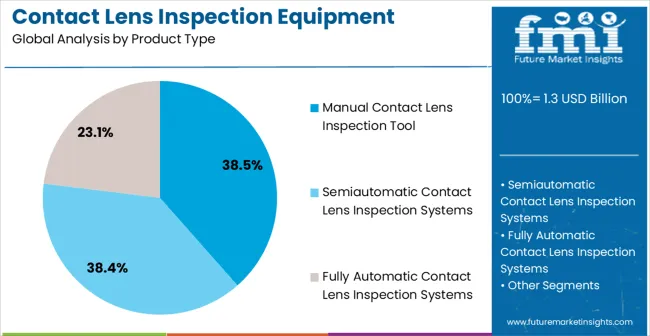
The manual contact lens inspection tool segment is projected to hold 38.5% of the market revenue in 2025, establishing it as the leading product type. Growth in this segment is being driven by its affordability, ease of use, and flexibility for small-scale production or quality control laboratories. Manual tools provide precise visual inspection capabilities, allowing operators to detect defects, impurities, or surface irregularities in contact lenses before distribution.
The simplicity of manual inspection devices enables rapid deployment without requiring extensive training or complex integration with existing systems. Additionally, these tools are preferred in regions with limited access to advanced automated solutions, as they provide reliable quality control while minimizing capital expenditure.
Consistent product quality, low operational costs, and adaptability for various lens types, including soft and rigid lenses, further reinforce market leadership As manufacturers continue to prioritize safety and compliance in lens production, manual contact lens inspection tools are expected to retain their dominant position, particularly in clinical and small-scale industrial applications.
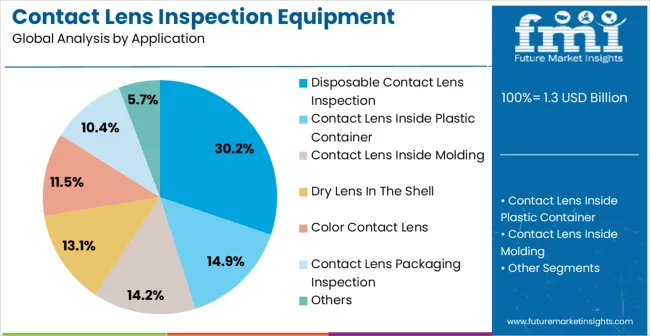
The disposable contact lens inspection application segment is anticipated to account for 30.2% of the market revenue in 2025, making it the leading application area. Growth in this segment is being driven by the rising demand for daily and monthly disposable lenses, which require rigorous inspection for defects, surface smoothness, and optical consistency. Inspection equipment ensures that lenses meet regulatory standards for hygiene, visual quality, and safety before reaching consumers.
The increasing adoption of disposable lenses due to convenience, comfort, and reduced risk of eye infections has amplified the need for specialized inspection processes. Advanced tools, including imaging systems and magnification devices, are enabling operators to efficiently monitor lens quality in large-scale production environments.
The focus on minimizing contamination and ensuring precise specifications has made disposable lens inspection critical to manufacturer reputation and regulatory compliance As the disposable lens market continues to expand, inspection equipment tailored to this application is expected to drive significant revenue growth, ensuring product reliability and consumer safety while supporting operational efficiency.
Automated contact lens inspection systems which consists of suitable light source, camera and image processing algorithms, for contact lenses defect inspection are gaining traction in terms of market growth owing to its ability to review the contact lens at production line with higher accuracy.
The newly introduced software programs coupled with automated contract lens inspection systems are providing an user friendly platform with higher test versatility. In addition, in-house programs developed to cater the specific requirements is anticipate to fuel the growth of customized lens inspection systems. The automatic contact lens inspection systems are mostly preferable used in soft contact lens inspections.
Ophthalmic product manufacturers have grown significantly from last few years in terms of research and development. Industrial inspection is a crucial part of manufacturing process for ophthalmic devices. Contact lenses are produced by injecting monomer solution in to the mold and then separated from the mold after cured in the oven.
Contact lenses shows number of manufacturing defects due to mechanical nature of separation form the mold and defects in molding process. Hence, the manufactured contract lens needs to be inspected for material safety, visual inspection for color, lens diameter, optical zone diameter, base curve radius, power, thickness, edge quality, performance testing before released in the market for sale.
The inspection of all above parameters require lengthy time on production line environment. As results, the ophthalmic product manufacturers have introduced an automated system which is used for contact lens inspection.
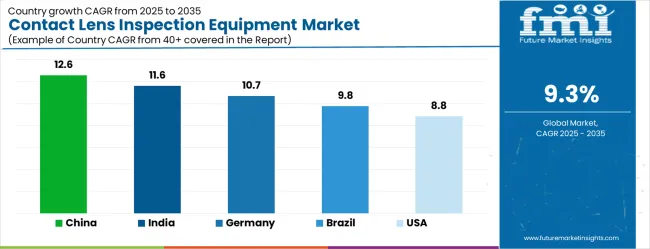
| Country | CAGR |
|---|---|
| China | 12.6% |
| India | 11.6% |
| Germany | 10.7% |
| Brazil | 9.8% |
| USA | 8.8% |
| U.K. | 7.9% |
| Japan | 7.0% |
The Contact Lens Inspection Equipment Market is expected to register a CAGR of 9.3% during the forecast period, exhibiting varied country level momentum. China leads with the highest CAGR of 12.6%, followed by India at 11.6%. Developed markets such as Germany, France, and the U.K. continue to expand steadily, while the U.S. is likely to grow at consistent rates. Japan posts the lowest CAGR at 7.0%, yet still underscores a broadly positive trajectory for the global Contact Lens Inspection Equipment Market. In 2024, Germany held a dominant revenue in the Western Europe market and is expected to grow with a CAGR of 10.7%. The U.S. Contact Lens Inspection Equipment Market is estimated to be valued at USD 460.9 million in 2025 and is anticipated to reach a valuation of USD 460.9 million by 2035. Sales are projected to rise at a CAGR of 0.0% over the forecast period between 2025 and 2035. While Japan and South Korea markets are estimated to be valued at USD 64.3 million and USD 33.9 million respectively in 2025.
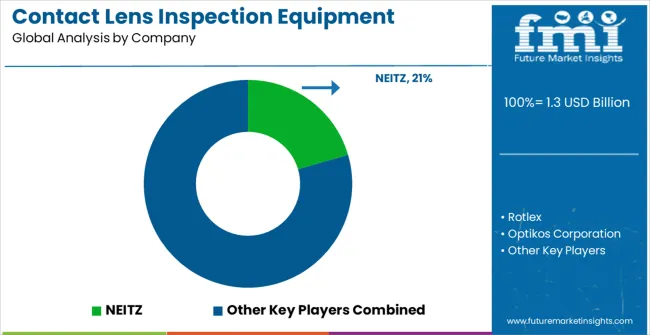
| Item | Value |
|---|---|
| Quantitative Units | USD 1.3 Billion |
| Product Type | Manual Contact Lens Inspection Tool, Semiautomatic Contact Lens Inspection Systems, and Fully Automatic Contact Lens Inspection Systems |
| Application | Disposable Contact Lens Inspection, Contact Lens Inside Plastic Container, Contact Lens Inside Molding, Dry Lens In The Shell, Color Contact Lens, Contact Lens Packaging Inspection, and Others |
| Regions Covered | North America, Europe, Asia-Pacific, Latin America, Middle East & Africa |
| Country Covered | United States, Canada, Germany, France, United Kingdom, China, Japan, India, Brazil, South Africa |
| Key Companies Profiled | NEITZ, Rotlex, Optikos Corporation, Contact Lens Technologists, Optimec Limited, NEITZ INSTRUMENTS, SPIE, and Qioptiq |
The global contact lens inspection equipment market is estimated to be valued at USD 1.3 billion in 2025.
The market size for the contact lens inspection equipment market is projected to reach USD 3.2 billion by 2035.
The contact lens inspection equipment market is expected to grow at a 9.3% CAGR between 2025 and 2035.
The key product types in contact lens inspection equipment market are manual contact lens inspection tool, semiautomatic contact lens inspection systems and fully automatic contact lens inspection systems.
In terms of application, disposable contact lens inspection segment to command 30.2% share in the contact lens inspection equipment market in 2025.






Our Research Products

The "Full Research Suite" delivers actionable market intel, deep dives on markets or technologies, so clients act faster, cut risk, and unlock growth.

The Leaderboard benchmarks and ranks top vendors, classifying them as Established Leaders, Leading Challengers, or Disruptors & Challengers.

Locates where complements amplify value and substitutes erode it, forecasting net impact by horizon

We deliver granular, decision-grade intel: market sizing, 5-year forecasts, pricing, adoption, usage, revenue, and operational KPIs—plus competitor tracking, regulation, and value chains—across 60 countries broadly.

Spot the shifts before they hit your P&L. We track inflection points, adoption curves, pricing moves, and ecosystem plays to show where demand is heading, why it is changing, and what to do next across high-growth markets and disruptive tech

Real-time reads of user behavior. We track shifting priorities, perceptions of today’s and next-gen services, and provider experience, then pace how fast tech moves from trial to adoption, blending buyer, consumer, and channel inputs with social signals (#WhySwitch, #UX).

Partner with our analyst team to build a custom report designed around your business priorities. From analysing market trends to assessing competitors or crafting bespoke datasets, we tailor insights to your needs.
Supplier Intelligence
Discovery & Profiling
Capacity & Footprint
Performance & Risk
Compliance & Governance
Commercial Readiness
Who Supplies Whom
Scorecards & Shortlists
Playbooks & Docs
Category Intelligence
Definition & Scope
Demand & Use Cases
Cost Drivers
Market Structure
Supply Chain Map
Trade & Policy
Operating Norms
Deliverables
Buyer Intelligence
Account Basics
Spend & Scope
Procurement Model
Vendor Requirements
Terms & Policies
Entry Strategy
Pain Points & Triggers
Outputs
Pricing Analysis
Benchmarks
Trends
Should-Cost
Indexation
Landed Cost
Commercial Terms
Deliverables
Brand Analysis
Positioning & Value Prop
Share & Presence
Customer Evidence
Go-to-Market
Digital & Reputation
Compliance & Trust
KPIs & Gaps
Outputs
Full Research Suite comprises of:
Market outlook & trends analysis
Interviews & case studies
Strategic recommendations
Vendor profiles & capabilities analysis
5-year forecasts
8 regions and 60+ country-level data splits
Market segment data splits
12 months of continuous data updates
DELIVERED AS:
PDF EXCEL ONLINE
Contact-lens Induced Infections Market Size and Share Forecast Outlook 2025 to 2035
Contact Lens Industry Analysis in GCC Size and Share Forecast Outlook 2025 to 2035
Contact Lenses Market – Trends, Growth & Forecast 2025 to 2035
Contact Lens Solution Market Analysis by Product Type, Volume, Purpose, Distribution Channel, and Region through 2035
Smart Contact Lens Market Size and Share Forecast Outlook 2025 to 2035
Hydrogel Contact Lenses Market
Disposable Contact Lenses Market Trends & Insights 2025-2035
Single Use Contact Lenses Market
Therapeutic Contact Lenses Market Report - Trends, Demand & Outlook 2025 to 2035
PCB Vision Inspection Equipment for SMT Market Size and Share Forecast Outlook 2025 to 2035
Semiconductor Defect Inspection Equipment Market Size and Share Forecast Outlook 2025 to 2035
Lens Analyzer Market Size and Share Forecast Outlook 2025 to 2035
Contact Cement Market Size and Share Forecast Outlook 2025 to 2035
Inspection Drone in Oil and Gas Market Size and Share Forecast Outlook 2025 to 2035
Inspection Management Software Market Size and Share Forecast Outlook 2025 to 2035
Inspection Robots Market Size and Share Forecast Outlook 2025 to 2035
Contactor Market Size and Share Forecast Outlook 2025 to 2035
Contactor-based Transfer Switch Market Size and Share Forecast Outlook 2025 to 2035
Equipment Management Software Market Size and Share Forecast Outlook 2025 to 2035
Contactless Delivery Services Market Size and Share Forecast Outlook 2025 to 2035

Thank you!
You will receive an email from our Business Development Manager. Please be sure to check your SPAM/JUNK folder too.
Chat With
MaRIA